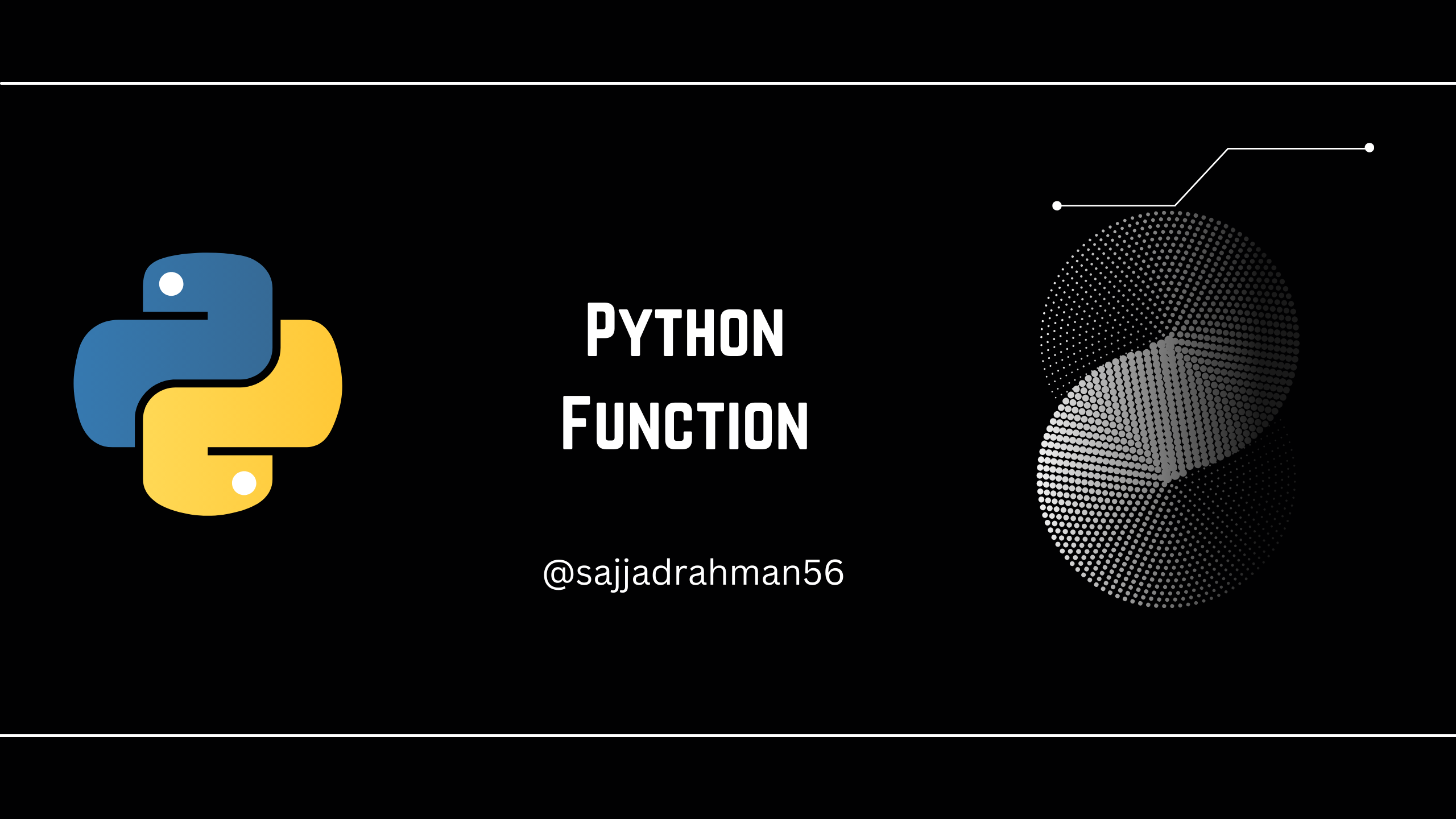Mastering Python Functions
 Sajjad Rahman
Sajjad Rahman
Introduction
In the world of programming, functions are indispensable. They allow us to encapsulate blocks of code, making it easier to organize, reuse, and maintain your codebase. Python, a versatile and widely used programming language, provides powerful tools for working with functions. In this guide, we will explore Python functions, from the basics to advanced techniques.
Basics of Python Functions
Defining a Function
In Python, functions are defined using the def keyword. You've already seen a simple example:
def sum():
a = 20
b = 30
return a + b
We'll dive deeper into function definition, parameters, and return values.
Breakdown the example here def is a keyword and sum() name of function and return means the function returns something.
# call the function
result = sum()
print(result) # we will get the value is 50 !
if you call the functions no of times we can not get different results as we did not change the value of a and b. Here the terms came function parameters.
Function Parameters
Function parameters in Python are like placeholders that allow you to pass data into a function. They are essential for customizing a function's behaviour and making it more versatile. Parameters are defined within the parentheses of a function's definition.
Positional Parameters
Positional parameters are the most common type of parameters in Python functions. When you define a function with parameters, the order in which you pass arguments to the function matters. These arguments are matched to the parameters based on their position.
Here's an example:
def greet(name, greeting):
return f"{greeting}, {name}!"
message = greet("Sajjad", "Hello")
print(message) # Hello Sajjad !
In this case, name is the first parameter, and greeting is the second parameter. When you call greet("Sajjad", "Hello"), the argument "Sajjad" is assigned to name, and "Hello" is assigned to greeting.
Default Parameters
Python allows us to specify default values for parameters. When a default value is provided, the parameter becomes optional when calling the function. If no value is passed for an optional parameter, it takes on the default value.
def power(base, exponent=2):
return base ** exponent
result1 = power(2) # The exponent defaults to 2
result2 = power(2, 3) # You can override the default value
# result1 is 4 (2^2), and result2 is 8 (2^3)
Keyword Parameters
You can pass arguments to a function using the parameter names as keywords.
def greet(name, country):
return f"{country}, {name}!"
message = greet(country="Bangladeh", name="Sajjad")
Keyword parameters are especially useful when a function has many parameters, and you want to make it clear which value corresponds to which parameter.
Variable-Length Argument Lists
In some cases, we might not know in advance how many arguments will be passed to a function. Python allows you to work with variable-length argument lists using the *args and **kwargs syntax.
*argscollects positional arguments into a tuple.**kwargscollects keyword arguments into a dictionary.
def print_args(*args, **kwargs):
print("Positional arguments:", args)
print("Keyword arguments:", kwargs)
print_args(1, 2, 3, a="apple", b="banana")
# Output:
# Positional arguments: (1, 2, 3)
# Keyword arguments: {'a': 'apple', 'b': 'banana'}
This flexibility is valuable when you want to create functions that can handle different numbers of arguments.
def two_sum(a, b):
return a + b
Here, a and b are parameters, allowing you to pass values to the function.
Return Values
Functions can return values using the return statement. In your code:
def sum():
a = 20
b = 30
return a + b
The return statement sends a result back to the caller. Earlier we the the method.
First thing first, return came from reusability. such as I want to add 30 + 30 another one add 2 numbers like 50 + 90. Do I write 2 methods for 2 people? Ok, I said that It is easy to write 2 functions but what if it is for 1000 people?
This is where return values shine. Let's explore why this is essential:
1. Passing Data Back to the Caller
Consider a function that calculates the sum of two numbers:
def add(a, b):
return a + b
By returning the result (a + b), the function add enables you to capture and use the sum elsewhere in your code. Here we just change the values of a and b it will give us an addition for any two numbers. For example
result = add(300, 4)
print(result) # Output: 304
2. Modularity and Reusability
Imagine you need to calculate the area of a rectangle in multiple places within your code. Without functions and return values, you'd have to duplicate the same code snippet. However returning the result, you achieve code modularity and reusability:
def calculate_area(length, width):
return length * width
Now, we can easily calculate the area of various rectangles without rewriting the formula every time.
3. Decision Making
Functions often perform tasks that lead to different outcomes or states. By returning a value, a function can communicate vital information that helps us make decisions or take specific actions in our code:
def is_even(number):
return number % 2 == 0
if is_even(6):
print("It's an even number.")
else:
print("It's an odd number.")
In this example, the is_even function's return value (True or False) . We can check any number whether it is ever or odd.
4. Chain Functions
We can pass the result of one function as an argument to another, creating a seamless sequence of operations:
def square(x):
return x ** 2
def add(a, b):
return a + b
result = add(square(3), square(4))
This code calculates the sum of the squares of 3 and 4, showcasing the elegance of function chaining. Before seeing this, we were familiar with one function now we can it is possible to pass a function as a parameter for another function.
More Function Techniques
In Python, we can work with lists as function parameters, allowing us to perform operations on lists and manipulate their contents
List as a Parameter
We can pass a list as a parameter to a function, treating it like any other variable. Consider a function that calculates the sum of all elements in a list:
def sum_list(numbers):
total = sum(numbers)
return total
In this example, numbers is a parameter that expects a list. Let's call this function and pass a list of numbers as an argument:
my_numbers = [1, 2, 3, 4, 5]
result = sum_list(my_numbers)
print(result) # Output: 15
Modifying a List
We can also modify the contents of a list passed as a parameter within a function. For instance
def add_element(my_list, element):
my_list.append(element)
my_list = [1, 2, 3]
add_element(my_list, 4)
print(my_list) # Output: [1, 2, 3, 4]
In this case, my_list is modified inside the add_element function.
Returning Lists
We can return lists from functions as well. Here's a function that filters even numbers from a list and returns them in a new list:
def even_numbers(numbers):
even_list = [num for num in numbers if num % 2 == 0]
return even_list
my_numbers = [1, 2, 3, 4, 5, 6, 7, 8]
result = even_numbers(my_numbers)
print(result) # Output: [2, 4, 6, 8]
Tuples from Functions
Tuples are ordered, immutable collections, often used to group related data. Here's how we can return tuples from functions:
Returning a Single Value as a Tuple
Even if a function returns a single value, we can wrap it in a tuple to provide clarity or compatibility with functions that expect multiple return values:
def get_version():
version_number = "1.2.3"
return (version_number,) # Return a single-element tuple
result = get_version()
print(result) # Output: ('1.2.3',)
Returning Multiple Values as a Tuple
Tuples are particularly useful when we want to return multiple values from a function. For example, consider a function that calculates both the sum and the average of a list of numbers:
def calculate_sum_and_average(numbers):
total = sum(numbers)
average = total / len(numbers)
return total, average # Return a tuple with two values
my_numbers = [1, 2, 3, 4, 5]
result = calculate_sum_and_average(my_numbers)
print(result) # Output: (15, 3.0)
By returning a tuple, we can conveniently access both the sum and the average using tuple unpacking.
Returning Multiple Values ( Tuples )
Functions can return more than one value. In your code, you used this to determine the employee of the month:
def employ_worker(works_hour):
current_max = 0
emp_of_month = ''
for emp, hours in works_hour:
if hours > current_max:
current_max = hours
emp_of_month = emp
return (emp_of_month, current_max)
works_hours = [('aba',400),('sam',780),('rakib',450)]
# touple return => we can say unpack
works_hours = [('aba',400),('sam',780),('rakib',450)]
def employee_check(works_hours):
current_max = 0
employee_of_month = ' '
for employee,hours in works_hours:
if hours > current_max:
current_max = hours
employee_of_month = employee
else:
pass
return (employee_of_month,current_max)
Great! Here's the conclusion section with the references included:
Conclusion
In this journey through Python functions, we've covered a wide range of topics. We began by understanding the basics of functions, from defining them to using parameters and return values effectively.
Happy coding! 🐍🚀
Reference
To Connect with me :
🐦 Twitter: @sajjadrahman56 🐦
🐙 GitHub: sajjadrahman56 🐙
🔗 LinkedIn: sajjadrahman56
Let's learn, collaborate, and grow together! 🚀
Subscribe to my newsletter
Read articles from Sajjad Rahman directly inside your inbox. Subscribe to the newsletter, and don't miss out.
Written by

Sajjad Rahman
Sajjad Rahman
As a Flutter developer, I am constantly learning and trying to implement new concepts into my projects. In addition, I devote time to studying Machine Learning. I have a passion for contributing to open-source projects.